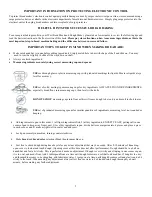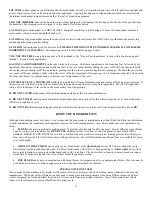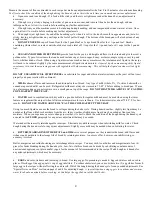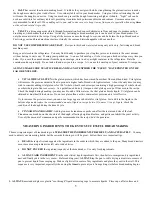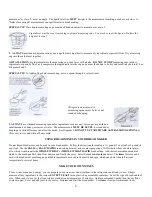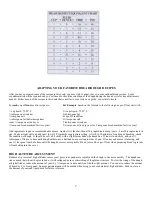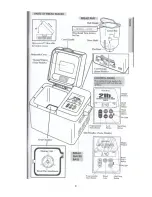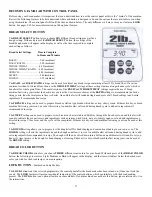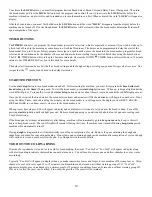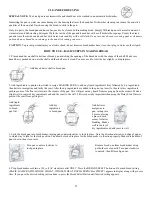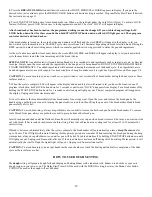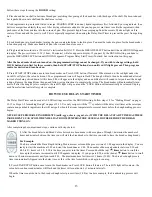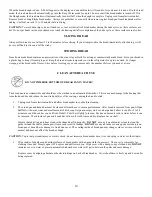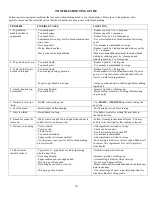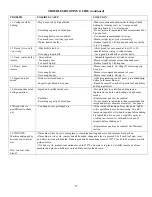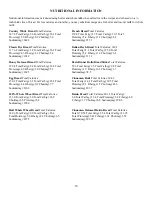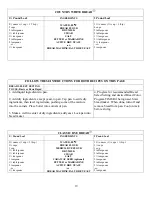
4
Measure the amount of flour as directed in each recipe but make any adjustment after the first 8 to 10 minutes of continuous kneading
.
Feel free to check the condition of the dough during the knead
cycle as this is the only time you can make any minor adjustment
:
•
Open cover and touch dough. If it feels a little sticky and there is a slight smear under the knead bar, no adjustment is
necessary.
•
If dough is very sticky, clinging to the sides of pan or in one corner, and is more like a batter than a dough, add one
tablespoon flour. Allow it to work in before making any further adjustment.
•
If dough is dry and the machine seems to be laboring during kneading, add one teaspoon lukewarm water at a time. Once
again, allow it to work in before making any further adjustments.
•
The dough is just right near the end of the kneading cycle when it is soft to the touch, smooth in appearance and just a bit
sticky, leaving a slight residue on your fingers-the feel of perfect dough. The bottom of the bread pan will also be clean of any
dough residue.
•
DO NOT EXCEED
4 cups of bread flour for the 2 pound loaf or 3 cups bread flour for the 1½ pound loaf. Breads
containing whole wheat, cereals or oats should not exceed a total of 3½ cups for the 1½ pound loaf or 4½ cups for the 2 pound
loaf.
•
SUGAR AND OTHER SWEETENERS
provide food for the yeast, add height and flavor to the bread and give the crust a
golden color. Types of sweeteners that can be used include sugar, brown sugar, honey, molasses, maple syrup, corn syrup and
fruits, whether dried or fresh. When using a liquid sweetener such as honey or molasses, the total amount of liquid in the recipe
will need to be reduced slightly by the same measurement of liquid sweetener used.
A special tip when measuring sticky liquid
sweeteners is to coat the measuring spoon with vegetable oil before measuring. This will help the liquid sweeteners slide right
out.
DO NOT USE ARTIFICIAL SWEETENERS
as a substitute for sugar and other natural sweeteners as the yeast will not react
properly and poor results will be obtained.
•
MILK
enhances flavor and increases the nutritional value of bread. Any type of milk (whole, 2%, 1%, skim, buttermilk or
canned evaporated milk) can be used. Refrigerated milk must always be warmed to 75-85° F before adding to bread pan. Warm
in a glass measuring cup in microwave or in a small pan on top of the range.
DO NOT HEAT MILK ABOVE 110° F AS THIS
COULD AFFECT THE YEAST.
•
WATER
used in combination with dry milk is a good substitute for regular milk and must be used when using the timer
feature as regular milk can spoil when left at room temperature for several hours. Use lukewarm water, about 75-85° F, for best
results.
DO NOT USE WATER ABOVE 110° F AS THIS COULD AFFECT THE YEAST
.
Using too much liquid can cause the bread to collapse during the bake cycle. During humid weather, slightly less liquid may be
needed as the flour will absorb moisture from the air. In dry weather, slightly more liquid may be needed as flour can lose
moisture. When you experience a severe change in weather, it is best to check the condition of the dough during the knead cycle
as noted in the
FLOUR
paragraph for any minor adjustment that may be needed.
Water and milk are mostly interchangeable in recipes. Eliminate dry milk in recipes when substituting milk for water. Check
dough during the knead cycle for any minor adjustments. Slightly more milk may be needed when substituting for water.
•
BUTTER, MARGARINE, OTHER FATS and OILS
serve several purposes as they tenderize the bread, add flavor and
richness and contribute to the storage life of bread by retaining moisture. An excess of fat, however, can inhibit rising, so
accuracy is critical.
Butter, margarine and solid shortening are interchangeable in recipes. You may wish to cut butter and margarine into four (4)
pieces for faster blending during the knead cycle. Low-fat or fat-free bread can be made by substituting equal amounts of
unsweetened applesauce or plain nonfat yogurt for the amount of fat recommended in the recipe. Watch dough as it kneads for
any minor adjustments, which may be necessary.
•
EGGS
add color, richness and leavening to bread. Use large eggs. No premixing is needed. Egg substitutes can be used in
place of fresh eggs. One egg equals ¼ cup of egg substitute. To reduce cholesterol, you can substitute two (2) egg whites for each
large egg in the recipes without affecting the end result. Watch the dough during the knead cycle for any needed adjustments. See
“Special Notes on Flour” section on pages 3 and 4 for adjusting dough.
A special tip when using eggs is to run them under warm
water for about one minute before cracking, as this helps the egg slide out of the shell better.
Summary of Contents for L4972T
Page 9: ...8...


